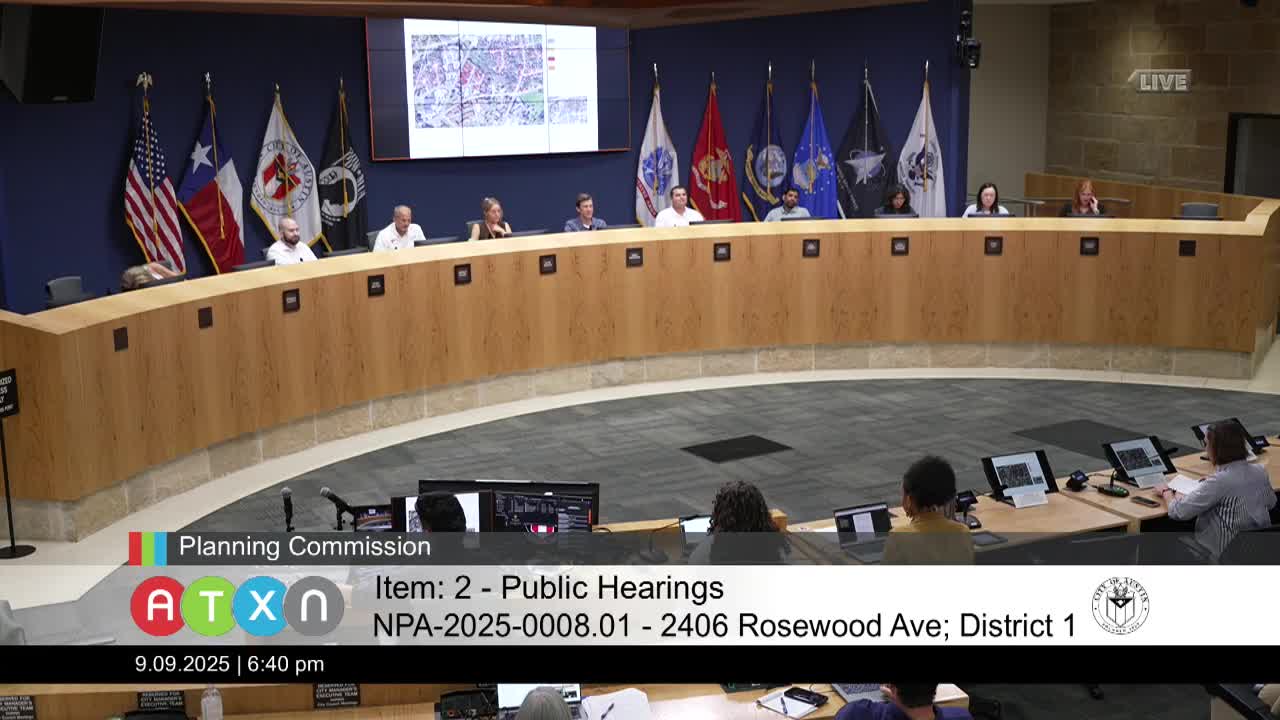Community Opposes Commercial Rezoning Near Rosewood Elementary School
September 09, 2025 | Austin, Travis County, Texas
This article was created by AI summarizing key points discussed. AI makes mistakes, so for full details and context, please refer to the video of the full meeting. Please report any errors so we can fix them. Report an error »

During a recent meeting of the Austin Planning Commission, significant discussions centered around a proposed rezoning application that has sparked community concern. The meeting highlighted the ongoing debate regarding the adaptive reuse of the historic Rosewood Elementary School and the implications of rezoning adjacent land for commercial use.
A commissioner expressed strong support for the developer's plan to retain and adaptively reuse the school while firmly opposing the rezoning application. This opposition stems from conversations with approximately 30 neighbors who believe that the proposed commercial zoning along Bedford and Soul Wilson Streets is inappropriate for the predominantly single-family residential neighborhood. The commissioner emphasized that the current residential character of these streets is incompatible with increased commercial traffic.
Visual aids presented during the meeting illustrated the surrounding area, showing a clear distinction between the residential streets and the more commercial thoroughfares. Bedford and Soul Wilson Streets, characterized as small residential streets that terminate in dead ends, lack the capacity to handle the traffic that would accompany commercial development. In contrast, nearby streets like Rosewood and Hargrave are major roads with higher traffic capacity and public transit access.
The commissioner argued that the proposed zoning changes would disrupt the neighborhood's balance and exacerbate existing traffic issues. The call for maintaining the current single-family zoning on the north side of the property reflects a broader concern for preserving the community's residential integrity.
As the Planning Commission continues to deliberate on this matter, the outcome of the rezoning application remains uncertain. The discussions underscore the ongoing tension between development and community preservation in Austin, highlighting the importance of considering local voices in planning decisions. The next steps will likely involve further community engagement and analysis of the proposed changes' potential impacts on the neighborhood.
A commissioner expressed strong support for the developer's plan to retain and adaptively reuse the school while firmly opposing the rezoning application. This opposition stems from conversations with approximately 30 neighbors who believe that the proposed commercial zoning along Bedford and Soul Wilson Streets is inappropriate for the predominantly single-family residential neighborhood. The commissioner emphasized that the current residential character of these streets is incompatible with increased commercial traffic.
Visual aids presented during the meeting illustrated the surrounding area, showing a clear distinction between the residential streets and the more commercial thoroughfares. Bedford and Soul Wilson Streets, characterized as small residential streets that terminate in dead ends, lack the capacity to handle the traffic that would accompany commercial development. In contrast, nearby streets like Rosewood and Hargrave are major roads with higher traffic capacity and public transit access.
The commissioner argued that the proposed zoning changes would disrupt the neighborhood's balance and exacerbate existing traffic issues. The call for maintaining the current single-family zoning on the north side of the property reflects a broader concern for preserving the community's residential integrity.
As the Planning Commission continues to deliberate on this matter, the outcome of the rezoning application remains uncertain. The discussions underscore the ongoing tension between development and community preservation in Austin, highlighting the importance of considering local voices in planning decisions. The next steps will likely involve further community engagement and analysis of the proposed changes' potential impacts on the neighborhood.
View full meeting
This article is based on a recent meeting—watch the full video and explore the complete transcript for deeper insights into the discussion.
View full meeting
